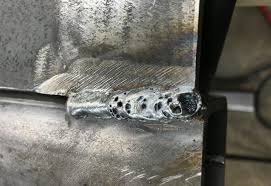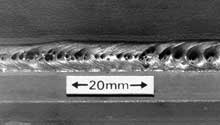What is Porosity in Welding: Comprehending Its Causes and Enhancing Your Skills
Wiki Article
Deciphering the Mystery of Porosity in Welding: Tips for Decreasing Flaws and Optimizing Quality
In the detailed globe of welding, porosity continues to be a persistent challenge that can dramatically impact the quality and stability of welded joints. As we delve into the depths of porosity in welding, uncovering the secrets to its prevention and control will be paramount for professionals seeking to grasp the art of top notch weldments.Understanding Porosity in Welding
Porosity in welding, a typical concern experienced by welders, refers to the existence of gas pockets or voids in the welded material, which can compromise the integrity and quality of the weld. These gas pockets are generally caught during the welding process due to numerous variables such as inappropriate securing gas, polluted base materials, or inaccurate welding parameters. The formation of porosity can weaken the weld, making it at risk to fracturing and deterioration, eventually bring about architectural failures.By identifying the relevance of preserving correct gas securing, making sure the tidiness of base materials, and maximizing welding setups, welders can substantially reduce the chance of porosity development. In general, an extensive understanding of porosity in welding is essential for welders to generate top notch and long lasting welds.

Typical Causes of Porosity
When inspecting welding procedures for potential top quality problems, recognizing the typical reasons of porosity is necessary for maintaining weld honesty and avoiding architectural failures. Porosity, identified by the existence of cavities or spaces in the weld metal, can substantially compromise the mechanical residential properties of a welded joint.
An additional prevalent root cause of porosity is the visibility of wetness and impurities on the surface of the base steel or filler material. When welding products are not appropriately cleaned or are subjected to high degrees of humidity, the evaporation of these contaminants during welding can develop voids within the weld bead. In addition, welding at improper specifications, such as exceedingly high travel speeds or currents, can create excessive turbulence in the weld swimming pool, capturing gases and causing porosity. By attending to these usual causes through appropriate gas securing, material preparation, and adherence to ideal welding criteria, welders can minimize porosity and enhance the high quality of their welds.
Methods for Porosity Avoidance
Carrying out reliable safety nets is essential in lessening the incident of porosity in welding procedures. One method for porosity avoidance is making sure correct cleansing of the base steel prior to welding. Pollutants such as oil, oil, rust, and paint can cause porosity, so complete cleansing utilizing suitable solvents or mechanical methods is necessary.
Utilizing top quality filler products and protecting gases that are suitable for the base steel and welding procedure can considerably reduce the danger of porosity. Additionally, keeping appropriate welding parameters, such as voltage, existing, travel speed, and gas circulation rate, is essential for porosity prevention.
Furthermore, using proper welding strategies, such as preserving a consistent traveling speed, electrode angle, and arc length, can aid stop porosity (What is Porosity). Adequate training of welders to guarantee they follow ideal practices and quality assurance treatments is likewise essential in decreasing porosity issues in welding
go to these guys

Finest Practices for High Quality Welds
Making certain adherence to sector standards and proper weld joint preparation are fundamental facets of accomplishing consistently top notch welds. In enhancement to these fundamental actions, there are a number of best techniques that welders can carry out to even more boost the high quality of their welds. One trick method is maintaining appropriate cleanliness in the welding location. Contaminants such as oil, oil, rust, and paint can detrimentally affect the top quality of the weld, resulting in issues. Completely cleansing the workpiece and bordering area before welding can aid reduce these concerns.An additional finest technique is to carefully choose the ideal welding parameters for the certain products being joined. This includes establishing the proper voltage, current, take a trip rate, and shielding gas flow rate. Correct criterion selection makes sure optimum weld infiltration, fusion, and general high quality. Making use of high-grade welding consumables, such as electrodes and filler metals, can considerably affect the final weld high quality. Purchasing costs consumables can cause more powerful, more resilient welds with less problems. By complying with these best practices, welders can regularly create top notch welds that fulfill sector criteria and go beyond consumer assumptions.
Relevance of Porosity Control
Porosity control plays a crucial duty in making certain the stability and high quality of welding joints. Porosity, characterized by the presence of dental caries or spaces within the weld metal, can significantly endanger the mechanical properties and architectural stability of the weld. Excessive porosity weakens the weld, making it extra prone to breaking, corrosion, and total failure under functional tons.Reliable porosity control is important for keeping the preferred mechanical properties, such as stamina, ductility, and toughness, of the bonded joint. What is Porosity. By minimizing porosity, welders can improve the total high quality and integrity of the weld, guaranteeing that it fulfills the performance demands why not try this out of the desired application
Additionally, porosity control is essential for achieving the preferred visual appearance of the weld. Extreme porosity not just compromises the weld however additionally detracts from its aesthetic allure, which can be vital in sectors where visual appeals are crucial. Correct porosity control techniques, such as utilizing the correct shielding gas, regulating the welding parameters, and making certain proper tidiness of the base products, are essential for creating top notch welds with minimal problems.

Final Thought
To conclude, porosity in welding is a typical issue that can compromise the high quality of the weld. By recognizing the causes of porosity and carrying out correct prevention methods, basics welders can decrease defects and accomplish greater top quality welds. It is important to manage porosity in welding to make certain the integrity and stamina of the last item. Applying best methods for porosity control is vital for attaining optimal welding results.Report this wiki page